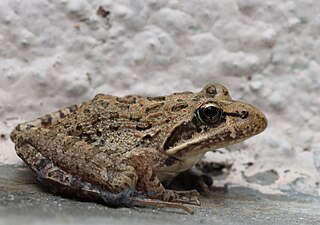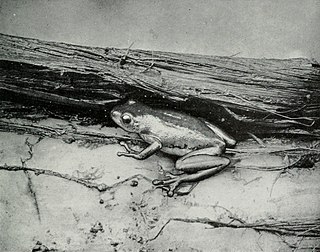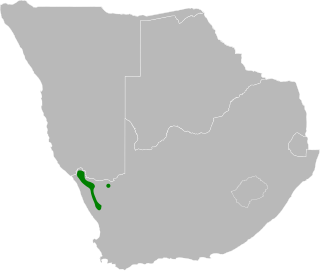
Strongylopus is a genus of pyxicephalid frogs native to Africa. They are found in the area from southwestern South Africa and Namibia to northern Tanzania. Their common name is stream frogs.
The Hispaniolan yellow tree frog, or common treefrog, is a species of frog in the family Hylidae endemic to Hispaniola, where it is found in both the Dominican Republic and Haiti.
Plectrohyla matudai is a species of frog in the family Hylidae. It is found along the Pacific slopes from southeastern Oaxaca, Mexico, through Chiapas and south-central Guatemala ; also in the Grijalva Depression in western Guatemala and on Cerro Azul in northwestern Honduras.

Hyperolius picturatus is a species of frog in the family Hyperoliidae. It is found in northern and eastern Sierra Leone, southern Guinea, Liberia, Ivory Coast, and Ghana; its range might extend to Togo. Common names coined for this species are Tanzania reed frog and variable montane sedge frog.
Hyperolius torrentis is a species of frog in the family Hyperoliidae. It is known from the Akwapim-Togo Ranges along the border between Ghana and Togo as well as from northeastern Benin. Common name Ukami reed frog has been coined for this species.

Leptopelis macrotis, sometimes called the big-eyed forest tree frog, is a species of frog in the family Arthroleptidae. It is found in the rainforests of Sierra Leone, southern Guinea, Liberia, Ivory Coast, and southern Ghana. Notice that similar common name "big-eyed tree frog" is sometimes used for Leptopelis vermiculatus from Tanzania and for Litoria exophthalmia from New Guinea.

The palmated chorus frog is a species of frog in the family Microhylidae. It is found in Indonesia and Malaysia. Its natural habitats are subtropical or tropical moist lowland forests, rivers, and freshwater marshes. It is not considered threatened by the IUCN.
Amolops lifanensis is a species of frog in the family Ranidae that is endemic to central Sichuan, China. It is a common species within its small range, living in and along streams in forests. It is locally threatened by dam construction.

Limnonectes palavanensis is a species of frog in the family Dicroglossidae. It is found in the Palawan Island and in Borneo. The species shows paternal care, a relatively rare trait in frogs.

Quasipaa exilispinosa is a species of frog in the family Dicroglossidae. It is known under many common names, including Hong Kong spiny frog, common spiny frog, lesser spiny frog, little spiny frog, and Hong Kong paa frog. It has a patchy distribution in southern China including Hong Kong. Its natural habitats are subtropical hill streams in forests or shrublands, and sometimes also seepages, stream-fed marshes, and forests. It is threatened by over-collecting for human consumption and by habitat loss.

The banded stream frog, also known as the banded sand frog, Cape grass frog, Cape stream frog, long-toed frog, mountain frog or Jonkersberg frog, is a species of frogs in the family Pyxicephalidae. It is endemic to South Africa.

Strongylopus fasciatus, also known as the striped stream frog, striped grass frog, striped rana, striped long-toed frog or long-toed grass frog is a species of frog in the family Pyxicephalidae. It is endemic to southern Africa.

Fuelleborn's stream frog or long-toed grass frog is a species of frog in the family Pyxicephalidae. It is found in the mountains of Malawi, Tanzania, and northeastern Zambia. Its natural habitats are montane grasslands at elevations of 1,500–3,000 m (4,900–9,800 ft) above sea level. Outside the breeding season, it can be found far from water. During the breeding season, males call from flooded grass. The egg clusters are laid just above streams, underneath dense vegetation. Tadpoles develop in the streams.

Gray's stream frog is a fairly small species of frog in the family Pyxicephalidae. It is a ground dweller, living mainly in vegetation such as sedges, generally brown, slenderly built and agile, with long, practically unwebbed toes.
Strongylopus kilimanjaro is a species of frog in the family Pyxicephalidae. It is endemic to Tanzania and only known from a narrow alpine range on the middle slopes of Mount Kilimanjaro, within the East African montane moorlands ecoregion. It is known only from three specimens collected in 1936. The lack of recent records is probably a reflection of very limited survey effort in the area since then.
Strongylopus merumontanus is a species of frog in the family Pyxicephalidae. It is found on Mount Meru in Tanzania, and according to some sources, the Nyika Plateau and Shire Highlands of Malawi. Common name Mt. Meru stream frog has been coined for it.
The Chimanimani stream frog is a species of frog in the family Pyxicephalidae found in Zimbabwe and Mozambique. Its natural habitats are subtropical or tropical moist montane forest, subtropical or tropical high-altitude shrubland, subtropical or tropical high-altitude grassland, and rivers. It is threatened by habitat loss.

The Namaqua stream frog is a species of frog in the family Pyxicephalidae found in South Africa and possibly Namibia. Its natural habitats are subtropical or tropical dry shrubland, Mediterranean-type shrubby vegetation, rivers, freshwater marshes, and intermittent freshwater marshes. It is threatened by habitat loss.
Wager's stream frog is a species of frog in the family Pyxicephalidae found in South Africa and possibly Lesotho and Eswatini. Its natural habitats are temperate forest, temperate grassland, and rivers. It is threatened by habitat loss.
Phrynobatrachus africanus is a species of frog in the family Phrynobatrachidae. It is found in Cameroon, Gabon, Equatorial Guinea, southwestern Central African Republic, western Republic of the Congo, and north-central Democratic Republic of the Congo. Its range might extend into Nigeria. The IUCN SSC Amphibian Specialist Group, however, considers the limits of its range unknown and does not include the Democratic Republic of the Congo in the range.










